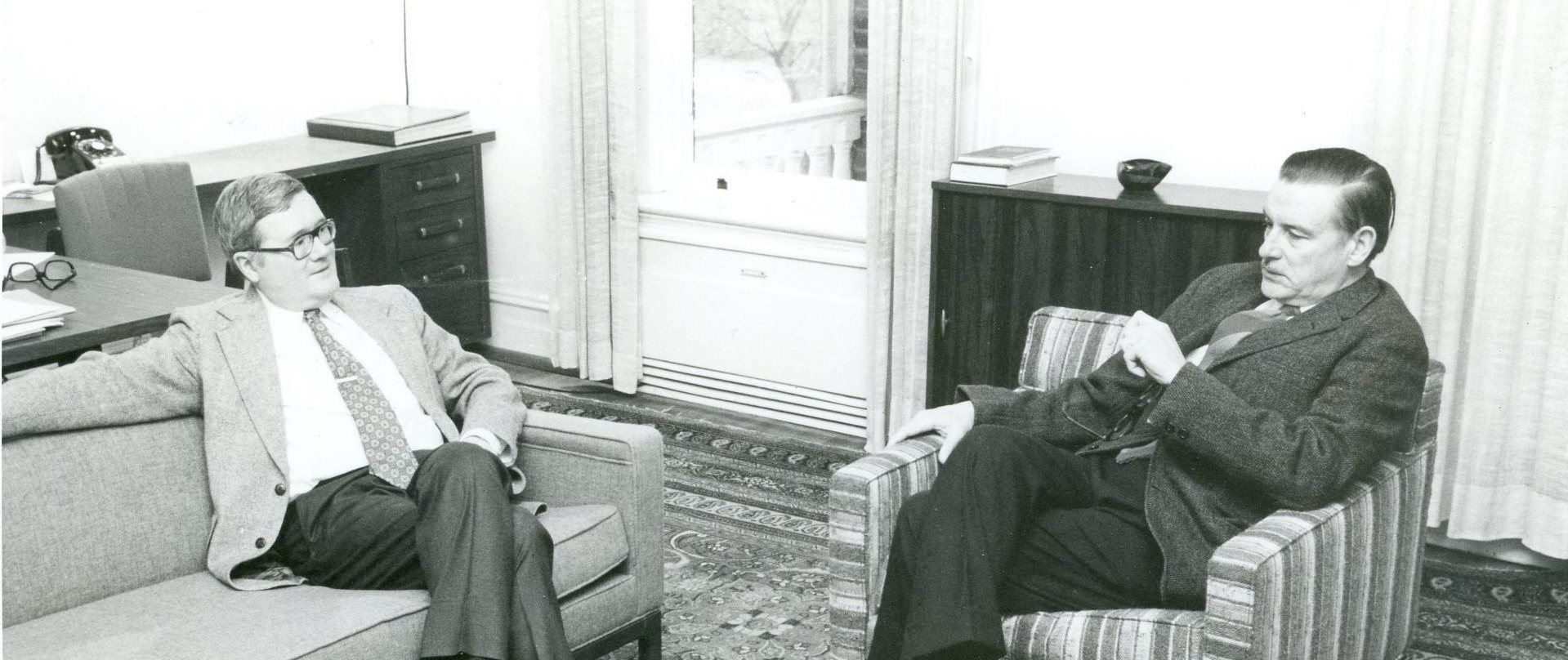How do you go about the process of writing? Nowadays we can choose from word processing software like Microsoft Word, collaborative tools like Google Docs, or professional-specific programs for screenwriters or mathematicians. For those of us used to the convenience of computers, it’s hard to imagine how the drafting process worked without them. We can learn a lot about James M. Buchanan’s drafting process from his papers, and see how technology available to us can influence our writing process.
Buchanan would draft papers both longhand on legal pads and in typewritten format. “A Behavioral Theory of Pollution,” eventually published in December 1968, had a first typewritten draft on February 19, 1968. No backspace key – revisions are made by typing over the written words with Xs.

First draft of “A Behavioral Theory of Pollution” by James Buchanan, February 19, 1968. James McGill Buchanan papers, C0246. Special Collections Research Center, George Mason University Libraries.
A second draft, on February 22 of the same year, is a new typewritten version with handwritten edits. No track changes on this document!

Second draft of “A Behavioral Theory of Pollution,” February 22, 1968. James McGill Buchanan papers, C0246. Special Collections Research Center, George Mason University Libraries.
Buchanan went back to writing longhand on a legal pad for the third draft, from September 1968. Having multiple versions of the same paper can show later researchers how Buchanan’s thoughts on a topic may have developed as he worked on a paper.

Revised third draft of “A Behavioral Theory of Pollution,” September 24, 1968. James McGill Buchanan papers, C0246. Special Collections Research Center, George Mason University Libraries.
Sometimes, a single legal pad couldn’t contain all of Buchanan’s thoughts on a topic. Computers automatically add new pages for us when we run out of space on the page, but sometimes Buchanan had to make his own space on a legal pad.

Draft of “In Defense of Budget Balance,” 1979. James McGill Buchanan papers, C0246. Special Collections Research Center, George Mason University Libraries.
Collaborating on articles and papers with multiple authors is easy nowadays with cloud-based software that lets you work simultaneously with people all over the world. Buchanan co-authored articles and books via mail, without the benefit of real-time edits. Instead, he and his co-authors would send drafts back and forth by mail, or work on them together in person. Milt Kafoglis sent along corrections to their 1963 article by postcard

Postcard from Milt Kafoglis to James Buchanan, February 10, 1963. James McGill Buchanan papers, C0246. Special Collections Research Center, George Mason University Libraries.
Buchanan and Gordon Tullock send drafts of their groundbreaking The Calculus of Consent by mail. They also experienced some of the difficulties when one writer is stuck and the other is racing ahead. (As mentioned in my previous blog post, Tullock was famous for his acerbic and biting sense of humor).

Letter from Gordon Tullock to James Buchanan, February 27, 1960. James McGill Buchanan papers, C0246. Special Collections Research Center, George Mason University Libraries.
We’re used to highlighting a section of a paper with our cursor and dropping a comment in the margins of a document. This reviewer left comments on one of Buchanan’s papers by clipping notes to the pages. Unfortunately the paper clips are now leaving rusty impressions on the paper and had to be removed. But the impressions they leave behind will show the researcher where the comments were originally left!

Draft, circa 1950s-1970s. James McGill Buchanan papers, C0246. Special Collections Research Center, George Mason University Libraries.
What happens when you want to add a paragraph to your co-author’s paper? Cutting and pasting was much more literal than today’s keystroke commands. Buchanan received this edited draft of The Reason for Rules from his co-author Geoffrey Brennan, where Brennan added a paragraph by physically cutting out an old section and pasting in a new one.

Draft of The Reason of Rules, September 1, 1983. James McGill Buchanan papers, C0246. Special Collections Research Center, George Mason University Libraries.
We can get so used to technology, seeing it as merely a tool, that we forget that it shapes how we do our work, and therefore the final product. How would your writing be different if you were limited to mailing your drafts to your co-authors? Or how was your writing different before you used computers? Archives can teach us about how important figures like James Buchanan did their work, but they can also cause us to reflect on our own current work processes that we often take for granted. What is gained and what is lost in the transition to new technology? It’s something to think about next time you open up your computer, sit down at your typewriter, or flip open your notebook and start writing.
Follow SCRC on Social Media and look out for future posts on our Facebook, Instagram, and Twitter accounts. To search the collections held at Special Collections Research Center, go to our website and browse the finding aids by subject or title. You may also e-mail us at speccoll@gmu.edu or call 703-993-2220 if you would like to schedule an appointment, request materials, or if you have questions.

